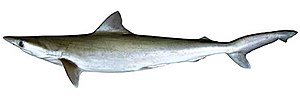Gray Sharpnose Shark
| Gray Sharpnose Shark | ||||||||||||
|---|---|---|---|---|---|---|---|---|---|---|---|---|

Gray Sharpnose Shark ( Rhizoprionodon oligolinx ) |
||||||||||||
| Systematics | ||||||||||||
|
||||||||||||
| Scientific name | ||||||||||||
| Rhizoprionodon oligolinx | ||||||||||||
| Springer , 1964 |
The gray sharp-nosed shark ( Rhizoprionodon oligolinx ) is a species of the sharp-nosed sharks ( Rhizoprionodon ) within the Requiem sharks (Carcharhinidae). The species is widespread in the tropical waters of the Indian to Pacific Ocean from the Arabian Peninsula to the Southeast Asian islands near Indonesia and Japan.
Appearance and characteristics
The gray sharp-nosed shark is a comparatively small shark with an average body length of around 50 cm and a maximum length of over 70 centimeters. He has a dark gray, gray-brown to bronze-colored body color and a lighter belly region without pattern. The tips of the fins are colored darker gray. The muzzle is long and the mouth is broadly parabolic when viewed from below, the eyes are large and are located relatively high up on the head. The nostrils are narrow and elongated, and the species only has short labial folds.
It has an anal fin and two dorsal fins . The first dorsal fin is significantly larger than the second and lies slightly in front of or over the free ends of the pectoral fins, while the second arises behind the anal fin. The anal fin is slightly larger than the second dorsal fin. The caudal fin has a relatively short lower and long upper lobe with a distinct end lobe. Like all species of the genus, the animals have five gill slits and no injection hole , the 4th and 5th gill slits are above the pectoral fin attachment.
Way of life
The gray sharp-nosed shark is a shallow water species, about whose way of life little information is available. It predatory feeds mainly on various fish , crustaceans , snails and octopuses . Like the related species, the sharks are viviparous and form a yolk sac placenta ( placental viviparous ). The three to five young are born with a length of about 21 to 26 cm, with a body length of about 30 to 40 cm, the animals are sexually mature.
distribution
The gray sharp-nosed shark is found in the tropical waters of the Indian to Pacific Ocean from the Arabian Peninsula to the Southeast Asian islands near Indonesia and the southern tip of Japan. Its habitat is in the area of the continental shelf in comparatively low water depths.
literature
- Leonard Compagno , Marc Dando, Sarah Fowler: Sharks of the World. Princeton Field Guides, Princeton University Press , Princeton and Oxford 2005; P. 319, ISBN 978-0-691-12072-0 .
Web links
- Gray Sharpnose Shark on Fishbase.org (English)
- Rhizoprionodon oligolinx inthe IUCN Red List of Threatened Species 2013.2. Listed by: Simpfendorfer, CA (SSG Australia & Oceania Regional Workshop, March 2003), 2003. Retrieved December 4, 2013.
